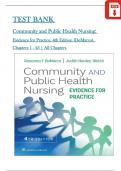TEST BANK
Community and Public Health Nursing:
Evidence for Practice, 4th Edition (DeMarco),
Chapters 1 - 25 | All Chapters
,TABLE OF CONTENTS
TF TF
,Chapter 1: Public Health Nursing TF TF TF TF
1. A nurse is striving to practice patient-
TF TF TF TF TF TF
centered care at a hospital. Which action bestexemplifies providing patient-
TF TF TF TF TF TF TF T
F TF TF
centered care? TF
A) Having a client complete a self-
TF TF TF TF TF
reported functional status indicator and thenreviewing it with the client
TF TF TF TF TF T
F TF TF TF TF
B) Explaining to a client the benefits of computer-
TF TF TF TF TF TF TF
assisted robotic surgicaltechniques, which the hospital recently imple
TF TF T
F TF TF TF TF TF
mented
C) Recording a client's signs and symptoms in an electronic health record
TF TF TF TF TF TF TF TF TF TF
D) Performing continuous glucose monitoring of a client while the client is in t
TF TF TF TF TF TF TF TF TF TF TF TF
hehospital
T
F
ANSWER: A TF
Feedback:
Patient-
centered care considers cultural traditions, personal preferences, values, families, and
TF TF TF TF TF TF TF TF TF T
lifestyles. Clients become active participants in their own care, and monitoring healt
F TF TF TF TF TF TF TF TF TF TF TF
h becomes the client's responsibility. To help clients and their healthcare providers
TF TF TF TF TF TF TF TF TF TF TF TF
make better decisions, the Agency for Healthcare Research and Quality (AHRQ) ha
TF TF TF TF TF TF TF TF TF TF TF
s developed a series of tools that empower clients and assist providers in achieving
TF TF TF TF TF TF TF TF TF TF TF TF TF TF
desired outcomes, including client-reported functional status indicators. Computer-
TF TF TF TF TF TF TF
assisted robotic surgical techniques, electronic health records, andcontinuous glucose
TF TF TF TF TF TF TF T
F TF TF
monitoring in the hospital are all technological advances in healthcare, but they do
TF TF TF TF TF TF TF TF TF TF TF TF TF
not help the client become a more active participant in his or hercare, and thus are
TF TF TF TF TF TF TF TF TF TF TF TF T
F TF TF TF T
not good examples of patient-centered care.
F TF TF TF TF TF
Origin: Chapter 1- Public Health Nursing, 2
T F TF TF TF TF TF
2. A nurse is caring for an older client who is struggling to manage her type 2 diabet
TF TF TF TF TF TF TF TF TF TF TF TF TF TF TF TF
es mellitus. The nurse should recognize which social determinants of this client's h
TF TF TF TF TF TF TF TF TF TF TF TF
ealth?(Select all that apply.)
T
F TF TF TF
, A) Household income of $23,000 per year
TF TF TF TF TF
B) Reading level of a third grader
TF TF TF TF TF
C) Medication ineffective due to error in prescription
TF TF TF TF TF TF
D) Originally from Sudan TF TF
E) No family in the are
TF TF TF TF
aANSWER:
T
F T F A, B, D, ETF TF TF
TF Feedback:
The social conditions in which people live, their income, social status, education, lit
TF TF TF TF TF TF TF TF TF TF TF TF
eracy, home and work environment, support networks, gender, culture, and availabili
TF TF TF TF TF TF TF TF TF TF
ty of health services are the social determinants of health. These conditions have an
TF TF TF TF TF TF TF TF TF TF TF TF TF T
impact on the extent to which a person or community possesses the physical, social
F TF TF TF TF TF TF TF TF TF TF TF TF TF
, and personal resources necessary to attain and maintain health. A medical erroron
TF TF TF TF TF TF TF TF TF TF TF TF T
F TF
the part of the client's primary care provider or nurse would not constitute a social
TF TF TF TF TF TF TF TF TF TF TF TF TF TF TF
determinant of the client's health. TF TF TF TF




